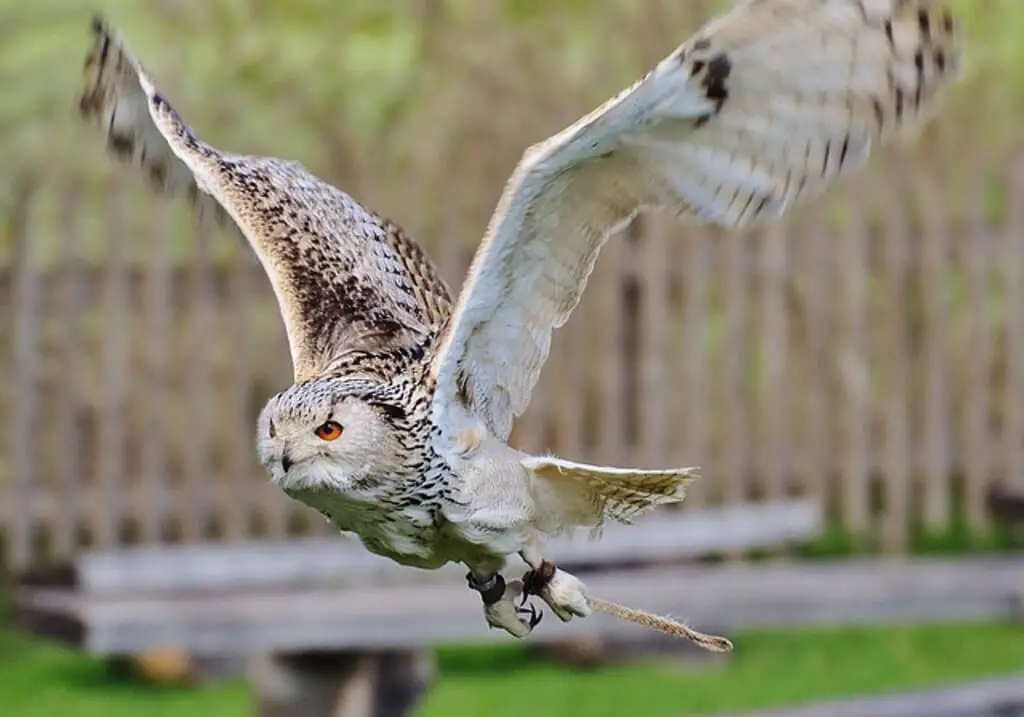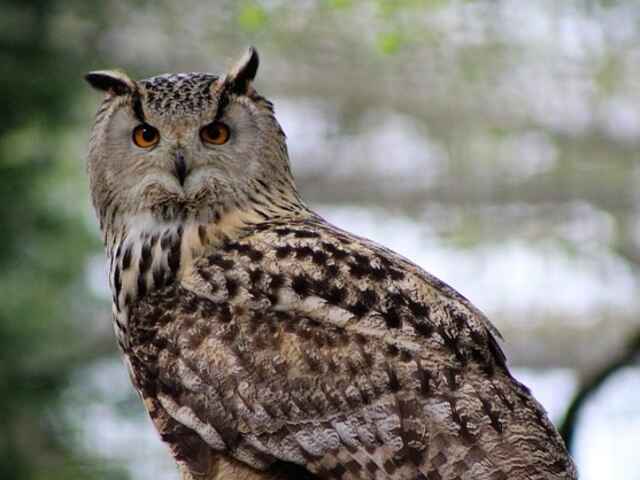Owls have captivated humans for centuries with their mysterious presence and nocturnal habits. Known for their silent flight and haunting calls, these remarkable birds offer a treasure trove of fascinating facts. From their unique anatomy to their diverse habitats and intriguing behaviors, there’s much to discover about these enigmatic nocturnal hunters. Whether you’re a seasoned birdwatcher or just curious, prepare to be amazed by the wonders of owls.
Table of Contents
- 1 Interesting Facts About Owls
- 1.1 The sound an owl makes is called “hooting”.
- 1.2 Some owls live in holes dug into tree trunks, or on the ground.
- 1.3 Owls have a heart rate of 250–400 beats per minute.
- 1.4 Some owls can turn their heads 270 degrees around.
- 1.5 There are about 200 owl species in the world.
- 1.6 The owl has 14 vertebrae, which is twice as many as humans.
- 1.7 Owls have over 200 bones in their body.
- 1.8 The Northern Pygmy Owl is the cutest owl out there!
- 1.9 The Elf Owl, is the smallest species of owl on earth.
- 1.10 Owls have excellent night vision.
- 1.11 Owls have asymmetrical ears to help them locate prey with sound.
- 1.12 Owls have incredible hearing ability
- 1.13 Owls have 3 eyelids.
- 1.14 Owls live in all parts of the world except for Antarctica.
- 1.15 The biggest owl is Blakiston’s Fish Owl.
- 1.16 Owls hooked beaks to help them rip flesh from their prey.
- 1.17 Owls are carnivorous and eat a variety of prey.
- 1.18 Owls have excellent hearing.
- 1.19 Owls possess sizable eyes that are stationary in their sockets.
- 1.20 Owls are mostly nocturnal.
- 1.21 Owl’s soft feathers assist them in hunting without noise.
- 1.22 Owls have existed for millions of years, according to fossil evidence.
- 1.23 Owls are solitary animals.
- 1.24 The historical significance of owls in different cultures
- 1.25 Owls can live for a long time.
- 1.26 Owls have been known to attack humans.
- 1.27 Owls are excellent hunters.
- 1.28 Owls have been used for pest control.
- 1.29 Owls have been trained for hunting.
- 1.30 Owls have a unique way of communicating.
- 1.31 Owls have been depicted in various works of literature and art.
- 1.32 Owls have been known to exhibit some unusual behaviors.
- 1.33 Owls have been used in scientific research.
- 1.34 Owls have been known to form lifelong partnerships.
- 1.35 Owls have been used in falconry.
- 1.36 Owls have been threatened by habitat loss and other factors.
- 1.37 Owls have been the subject of many myths and legends.
- 1.38 Owls have been used in traditional medicine.
- 1.39 Owls have been featured in many movies and TV shows.
- 1.40 Owls have been used as symbols in advertising.
- 1.41 Owls are fascinating creatures that continue to capture our imaginations.
- 2 Conclusion
- 3 Author
Interesting Facts About Owls
The sound an owl makes is called “hooting”.
The sound an owl makes is called “hooting” which is caused by air moving through their lungs as they exhale. The sound of an owl hooting can be heard for a mile or more away from the source, and it can echo off hillsides and buildings to carry even farther.
Some owls live in holes dug into tree trunks, or on the ground.
Many owls are found in forests and can live in tree trunks or make nests on the ground. One type of owl, the burrowing owl, lives most of its life underground where it digs a nest with its claws into an old tree trunk to keep warm. The long-eared owl is another species that builds nests in holes dug into trees.
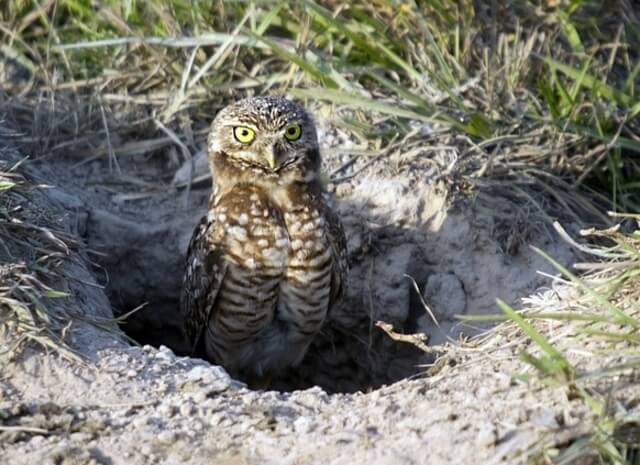
Owls have a heart rate of 250–400 beats per minute.
One adaptation that may not be as well known is their high heart rate, which ranges from 250 to 400 beats per minute. A normal human heart rate ranges between 60–100 beats per minute.
One reason for the higher rate in owls is their constant need to maintain warmth by regulating their body temperature through cooling down or warming up feathers.
Some owls can turn their heads 270 degrees around.
There are different species of owls, and they all have their own characteristics. Some can turn their heads 270 degrees around, some cannot. The typical bird has a 180 degree range of movement, but the owl’s neck is designed to twist its head around, which enables it to see in almost every direction.
There are about 200 owl species in the world.
Owls are among the most diverse groups of birds in the world, with about 200 species found on every continent except Antarctica. Though only 19 species live in North America, they make up one-third of all bird species here.
The owl has 14 vertebrae, which is twice as many as humans.
The owl has 14 vertebrae, which is twice as many as humans. These extra vertebrae allow for a wide range of movement and flexibility in the neck that allows them to turn their head 270 degrees either way and look behind themselves without moving their body.
Owls have over 200 bones in their body.
Owls are incredible creatures with a surprising number of bones in their body. The bones in an owl’s wings make up only 2% of the wing’s total weight, but they provide a crucial amount of support for flight. An owl has more than 200 different types of bone that account for about 9% of its total body weight.
The Northern Pygmy Owl is the cutest owl out there!
The Northern Pygmy Owl has a heart shaped face, making it the cutest owl out there! The little pygmy is native to Canada and Alaska and can often be found in forests near rivers or lakes.
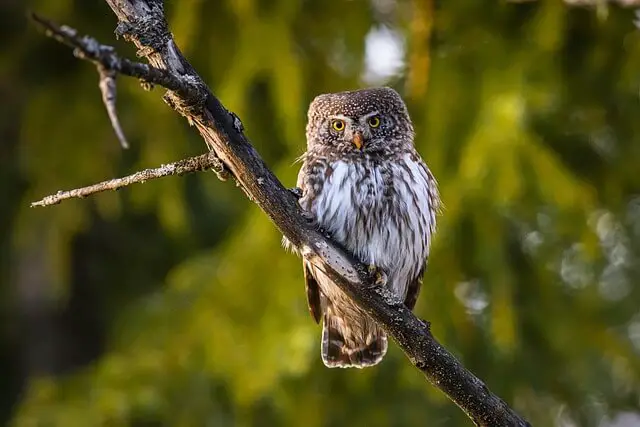
The Elf Owl, is the smallest species of owl on earth.
The Elf Owl, is the smallest species of owl on earth. They are typically 5–6 inches tall and have a wingspan of about 10–11 inches, with an average weight of 1.5 ounces (42.5 grams).
They live in both South America and North America. It can be found living in plantations, orchards, parks and gardens where it eats insects like crickets, moths and beetles.
Owls have excellent night vision.
Owls are unique creatures, with a natural ability to hunt at night. They have large forward-facing eyes and binocular vision for excellent night vision. These amazing adaptations make them perfect hunters in the dark of night.
Owls have asymmetrical ears to help them locate prey with sound.
Owls are nocturnal predators and rely on their sense of hearing to locate prey. The asymmetrical ears, one is larger than the other, provide a broader range of sound detection which aids in locating potential food sources or prey.
Owls have incredible hearing ability
Owls have the best hearing of any animal. They can hear a mouse moving on the ground, or an insect rustling in leaves from up to two miles away. This is because owls have asymmetrical ears and three separate ear openings for better directional hearing.
In contrast, humans have symmetrical ears with only one opening per ear that points forward and to each side, limiting our ability to detect sounds coming from behind us.

Owls have 3 eyelids.
Owls have 3 eyelids. These three lids are the nictitating membrane, a thin layer of tissue that protects the eye from dust and injury; the cornea, which is responsible for about two-thirds of an owl’s vision; and finally, a third lid called the haw. The owls use their haw to protect their eyes while they’re hunting prey in close quarters like tree branches or deep crevices.
Owls live in all parts of the world except for Antarctica.
Owls are found in all parts of the world except for Antarctica. This is because owls cannot live in a place where they do not have any trees to roost on, and there are no trees on the Antarctic continent. These nocturnal birds of prey have a wide variety of habitats, including deserts, forests, and even rainforests.
The biggest owl is Blakiston’s Fish Owl.
The biggest owl in the world is Blakiston’s Fish Owl, measuring 25-28 inches in length and weighing an average of 7.5 pounds, with a 6 ft wingspan.
They live near large bodies of water and feed on fish, crustaceans, amphibians, small mammals and reptiles. Blakiston’s Fish Owls are found near large bodies of water like lakes or rivers.
Owls hooked beaks to help them rip flesh from their prey.
Owls don’t have teeth, but they do have hooked beaks to help them rip flesh from their prey. These beaks are so sharp that some owls can tear the feathers off of their prey with just one swipe. The beak is used like a knife as it cuts through the meat and pulls it back out.
Owls are carnivorous and eat a variety of prey.
Their diet includes rodents, birds, insects, fish, and even other owls. Some species, like the snowy owl, can eat up to 1,600 lemmings per year. Owls swallow their prey whole and later regurgitate pellets of undigested bones, fur, and feathers.
Owls have excellent hearing.
Their ears are located at different heights on their head, which helps them pinpoint the location of sounds. Owls have some of the most sensitive hearing of any animal, and can hear prey moving under snow, leaves, or grass. Owls have the ability to hear sounds that are outside the audible range of humans, both too high-pitched and too low-pitched.
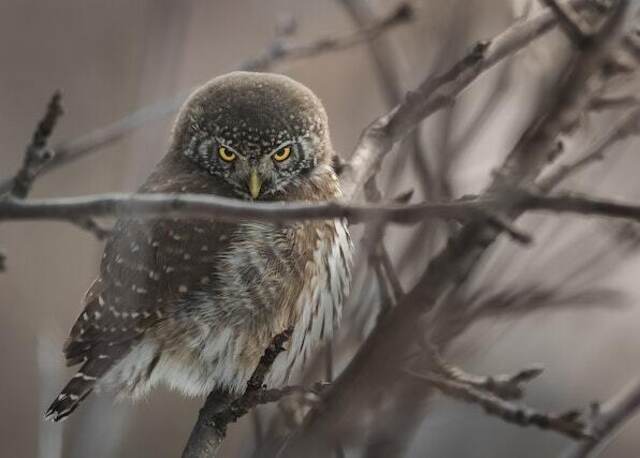
Owls possess sizable eyes that are stationary in their sockets.
This means they have to turn their entire head to look around. Owls have some of the largest eyes of any bird, and their eyes are specially adapted for low light conditions. They have a high concentration of light-sensitive cells called rods, which help them see in the dark.
Owls are mostly nocturnal.
During the day, owls usually sleep, while they are most active at night. However, some species, like the snowy owl, are active during the day as well. Owls are adapted to hunting in low light conditions and have excellent night vision.
Owl’s soft feathers assist them in hunting without noise.
This ability enables them to approach their prey stealthily and unheard. Their feathers have a special fringe that muffles the sound of air rushing over their wings. This adaptation makes them some of the quietest fliers in the animal kingdom.
Owls have existed for millions of years, according to fossil evidence.
Fossil evidence shows that they have been around for at least 60 million years. They have evolved many unique adaptations that make them successful predators, including their silent flight, excellent hearing, and sharp talons.
Owls are solitary animals.
They usually only come together to mate or raise young. Some species, like the snowy owl, may gather in large groups during the winter to hunt and roost.
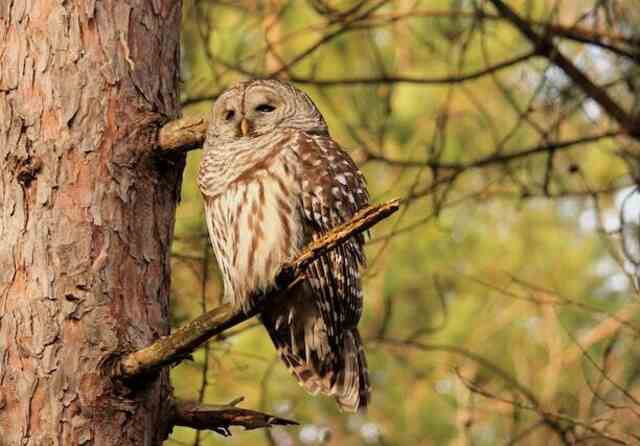
The historical significance of owls in different cultures
They have been revered as symbols of wisdom, death, and magic. During the period of Ancient Greece, Athena, the goddess of wisdom, was often represented by the owl. In Native American cultures, the owl was often associated with death and the afterlife.
Owls can live for a long time.
Certain owl species have the ability to survive up to 25 years in their natural habitat. However, many owls do not survive their first year of life due to predation, disease, or starvation.
Owls have been known to attack humans.
This is rare, but it can happen if an owl feels threatened or is defending its nest. Most owl attacks occur during the nesting season, when owls are more protective of their young.
Owls are excellent hunters.
With their razor-sharp talons and hooked beaks, owls can swiftly capture and dispatch their prey. Some species, like the great horned owl, can take down prey that is much larger than themselves.
Owls have been used for pest control.
Some farmers and gardeners use owls to control rodent populations. Owls are natural predators of rodents and can help reduce their numbers without the use of pesticides.

Owls have been trained for hunting.
In some cultures, owls have been trained to hunt small game like rabbits and squirrels. This practice is still used in some parts of the world today.
Owls have a unique way of communicating.
Instead of singing like many birds, owls use a variety of hoots, screeches, and whistles to communicate with each other. Each species has its own distinct call, which can be used to identify them.
Owls have been depicted in various works of literature and art.
From Harry Potter’s pet owl Hedwig to the wise old owl in A.A. Milne’s Winnie-the-Pooh, owls have captured the imaginations of people for centuries. They have also been featured in many works of art, from ancient cave paintings to modern-day sculptures.
Owls have been known to exhibit some unusual behaviors.
For example, some species of owls will “sunbathe” by spreading their wings and basking in the sun. Others will “ant” by rubbing ants on their feathers, which helps to get rid of parasites.
Owls have been used in scientific research.
Their unique adaptations, such as their silent flight and excellent hearing, have made them a popular subject of scientific study. Researchers have used owls to study everything from auditory processing to biomechanics.
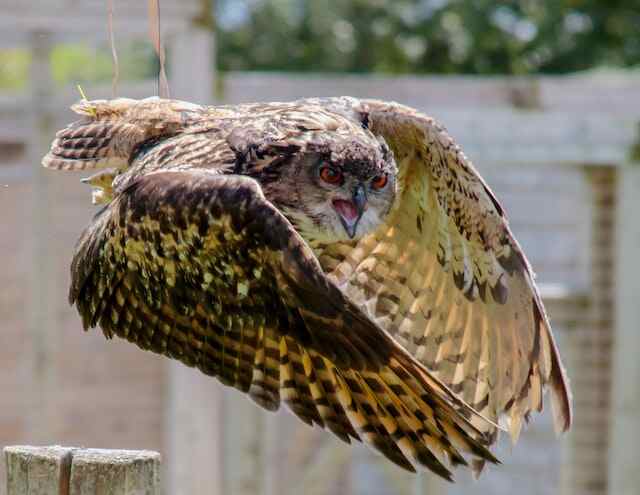
Owls have been known to form lifelong partnerships.
Some species of owls, like the barn owl, mate for life and will stay with their mate year-round. They will often roost together during the day and hunt together at night.
Owls have been used in falconry.
Falconers have used owls to hunt small game for centuries. Some species, like the Eurasian eagle owl, are particularly well-suited to this type of hunting.
Owls have been threatened by habitat loss and other factors.
Many species of owls are threatened by habitat loss, climate change, and other factors. Efforts are being made to conserve these captivating birds and preserve their natural habitats.
Owls have been the subject of many myths and legends.
In some cultures, owls are believed to be harbingers of death or bad luck. In some cultures, owls are viewed as representations of knowledge and positive outcomes.
Owls have been used in traditional medicine.
Owls have been used in traditional medicine. In some cultures, owl parts have been used in traditional medicine for a variety of ailments. For example, owl eggs were once believed to improve eyesight, while owl feathers were used to treat asthma.
Owls have been featured in many movies and TV shows.
From the wise old owl in Winnie-the-Pooh to the titular character in the movie Legend of the Guardians: The Owls of Ga’Hoole, owls have been a popular subject in popular culture.
Owls have been used as symbols in advertising.
Owls have been used to sell everything from coffee to beer to clothing. Their association with wisdom and intelligence makes them a popular choice for advertisers.
Owls are fascinating creatures that continue to capture our imaginations.
From their silent flight to their unique adaptations, owls are truly remarkable birds. Owls are fascinating creatures that can captivate and inspire birdwatchers, nature enthusiasts, and anyone who appreciates the beauty of the natural world.
Conclusion
In conclusion, owls are fascinating creatures with many unique and interesting qualities. From their silent flight to their exceptional eyesight, there is much to learn and appreciate about these majestic birds.
We hope these fun facts have given you a new appreciation for owls and their place in the natural world. Keep exploring and learning about these amazing creatures!
Handpicked Related Post:

